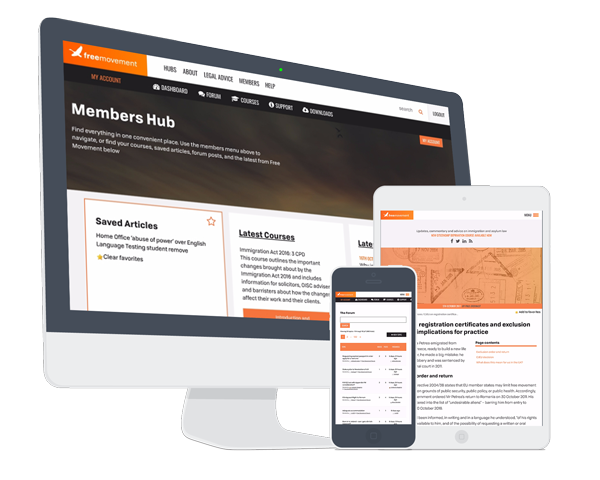- BY Sonia Lenegan

Latest statistics raise questions around sustainability of Home Office asylum decision making
THANKS FOR READING
Older content is locked

A great deal of time and effort goes into producing the information on Free Movement, become a member of Free Movement to get unlimited access to all articles, and much, much more
TAKE FREE MOVEMENT FURTHER
By becoming a member of Free Movement, you not only support the hard-work that goes into maintaining the website, but get access to premium features;
- Single login for personal use
- FREE downloads of Free Movement ebooks
- Access to all Free Movement blog content
- Access to all our online training materials
- Access to our busy forums
- Downloadable CPD certificates
Table of Contents
ToggleThe quarterly immigration and asylum statistics covering the period April to June 2025 have been published by the Home Office. A couple of notable points on the asylum front is the increase in Palestinians arriving in the UK across the Channel and some fairly suspicious silence from the Home Office on the outcomes of internal quality reviews as well as the sustainability at appeal stage of their decisions. I also take a look at the implications of some of these statistics for the new UK/France agreement.
Asylum
The initial decision backlog is down 18% to 70,532 cases (relating to 90,812 people) as at the end of June 2025, however my view is that this drop is fairly meaningless and the backlog should really be considered as a whole along with the tribunal backlog. With this proper context, it is unsurprising that despite the drop in cases waiting for an initial decision, there has been an increase in people in asylum accommodation (8% for hotels, 6% for others) in the year ending June 2025.
The overall grant rate for asylum cases in the year ending June 2025 was 48%, down from 58% the previous year (it was 77% in September 2022). As indicated above, these cases will now move into the tribunal backlog, where many decision will be overturned because of poor Home Office decision making.

The Home Office has not published data on decision quality for the year 2024/25, the last update was published in the August 2024 batch of statistics, so it seems that we were due a fairly important update which is missing. The most recent data for 2023/24 (table ADQ_01A) shows that only 52% of decisions were passing their own internal quality checks.
This means that while dramatically ramping up refusals, the quality of Home Office decisions is extremely poor and so many of the decisions will be unsustainable.
For example, the grant rate in Afghan asylum claims has dropped from 96% in the year ending June 2024 to 40% in the year ending June 2025. Practitioners are reporting that some Afghan refusals are being withdrawn by the Home Office at appeal stage and people are granted refugee status instead. The Home Office has not reported on appeal outcomes since the first quarter of 2023, so these cases are completely hidden in the statistics.
So the important data that we are missing is 1) the latest data on internal quality checks and 2) how many decisions the Home Office withdraws at appeal stage and subsequently grants the person leave. This is incredibly important context when it comes to the handling of the backlog of asylum claims, the shift of poorly decided cases into the tribunal and cost of that to Ministry of Justice, as well as the associated concerns around the cost of asylum support. Parliamentarians may want to start asking questions.
Irregular arrivals are up 27% on the previous year to 49,341 people, 88% of whom arrived by small boat.

There were 210 Palestinians who arrived in the UK via small boat in the period April to June 2025. There has been a steady increase each quarter since the end of 2023, although this most recent quarter shows a large increase from the 56 people who arrived between January and March this year.
UK/France agreement
The guidance for the UK/European Applicant Transfer Scheme states that “Applicants who satisfy the high grant or high volume nationality selection criteria will be considered first against the validity requirements of the Immigration Rules Appendix UK/European Applicant Transfer Scheme” and that the quarterly statistics will be used to determine what these nationalities are. We are publishing a detailed briefing on the guidance next week, but in brief, high grant nationalities are where all of the following are met:
- at least 25 substantive asylum decisions on applications from individuals of the same nationality have been made in the most recent reporting quarter
- at least 100 substantive asylum decisions on applications from individuals of the same nationality have been made in the most recent reporting year
- at least 80% of substantive asylum decisions made in the most recent reporting year have been a decision to grant protection status in the first instance
Afghans would therefore be excluded under the high grant nationality criteria because of the low grant rate, however the high volume nationality is offered as an alternative, and the guidance defines this as:
High volume nationalities are the 3 nationalities with the highest volume of recorded arrivals from dangerous journeys made by small boat from France to the UK between January and March 2025.
The guidance says this will be updated in line with the most recent quarterly statistics. For April to June 2025 the three highest nationalities making the crossing were Eritreans (2,240), Afghans (1,455) and Sudanese (1,309).
This seems to create a slightly perverse situation where Afghans will be able to apply to come to the UK under the scheme, only for the Home Office to refuse their asylum claim, albeit that the claim seems likely to later succeed, not least because the Home Office is not returning people to Afghanistan. The data on returns on shows that eight Afghans have been forcibly returned in the year ending June 2025.
Apart from Afghans, concerns have already been raised about the ability of Eritreans in particular to comply with the documentation required to apply under the scheme. It is also worth noting that 673 stateless people made the crossing by small boat in the period April to June 2025 and this group is excluded from coming to the UK under this scheme.
Refugee family reunion
There is good news for refugees in the UK who want to bring their family over, as we can see that 20,817 people were granted permission to come to the UK under refugee family reunion in the year ending June 2025.

Asylum claims based on sexual orientation
The Home Office has not published its usual summary on asylum claims based on sexual orientation. It is bad enough that these figures were published with such a time lag – every August the Home Office published data only going up to June of the previous year, whereas the rest of the statistics cover all of the following year too, making comparisons and trends far more difficult.
However this year the Home Office has published only a table of the statistics which although dated up to the end of June 2024 does not provide any data for 2024. The general asylum summary refers to statistics from 2023. I don’t think that they have just been moved to a different section of the statistics (a fun game the Home Office sometimes likes to play is “hide and seek” the statistics) and I can’t see that any explanation for the absence has been provided.
EU Settlement Scheme
Let’s keep the good news going while we can, since the process started in January this year, 37,260 people have had their pre-settled status upgraded to settled status by the Home Office without the need to make an application, amounting to 11% of all grants of settled status in the year ending June 2025.

Work routes and civil penalties
182,553 visas were granted to main applicants in work categories in the year to June 2025, down 36%. The Home Office explains the decrease as being “likely due to more scrutiny applied by the Home Office to employers in the health and social care sector, and compliance activity taken against employers who did not fulfil their obligations as employers of migrant workers, as well as the recent policy measures affecting care workers introduced in Spring 2024”.
The policy changes referred to were changes to the immigration rules that came into force in March 2024 removing the ability of care workers to bring their family with them. The impact has been stark, as seen on the below chart.

The number of Health and Care Worker visas issued to those working in the Caring Personal Service category fell by 88% to 7,378 in the year ending June 2025.
On compliance, there continues to be a huge amount of enforcement activity taken against sponsor licence holders, with 869 skilled worker licence suspensions in the period April to June 2025 and 767 revocations, up from 339 suspensions and 276 revocations in the period January to March 2025. There was a slight decrease in the number of temporary worker revocations, down to 20 from 25 the previous quarter.
The Home Office has also published data on civil penalties issued to employers relating to illegal working.

However it is important to remember that fines issued is not the same as fines collected, the latter being data that the Home Office does hold, but does not publish voluntarily.
Students
Since most students were prevented from bringing their partner and children with them to the UK, there has been a slight drop in main applicant numbers (4%) in the year on year figures, but an 18% increase in the first half of 2025.

Conclusion
As we can see above with not just asylum and appeals but also civil penalties, there does seem to be an element of the Home Office only showing us what they want us to see, particularly with the summaries. I also poked around in the citizenship data to see if there was anything on refusals of applications made by refugees, given the changes earlier this year, but that data is also not reported on. I can’t be the only one who misses this level of public scrutiny.
SHARE

